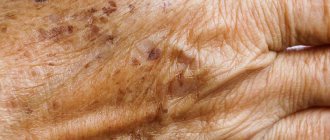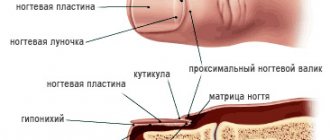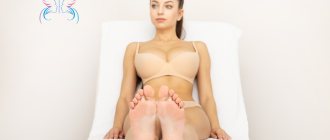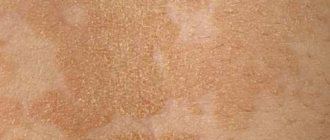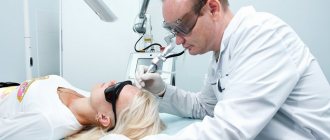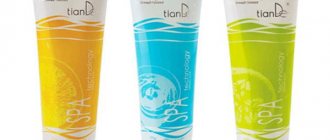From this article you will learn:
- How does hyperhidrosis manifest?
- What are the advantages and disadvantages of laser treatment for hyperhidrosis?
- What is the essence of laser treatment for hyperhidrosis and how is it carried out?
Laser treatment of hyperhidrosis is a modern procedure that is an alternative to risky surgical interventions. Every tenth person suffers from mild sweating. But everything is much more problematic with excessive sweating. We'll talk about it in our article.
How does hyperhidrosis manifest?
Hyperhidrosis is a pathological condition accompanied by increased sweating of the whole body (generalized form) or individual parts of it (idiopathic form) - armpits, feet, palms, large skin folds in obesity. Local forms of hyperhidrosis are much more common.
Sweating is an important physiological process necessary for:
- thermoregulation of the body;
- maintaining water-salt balance;
- regulation of metabolism and removal of toxins.
Sweat is secreted onto the surface of the skin by special exocrine glands, which are located over almost the entire surface of the body (with the exception of the genitals). Sometimes in some areas they begin to work with abnormal intensity as a result of non-compliance with personal hygiene rules or the presence of certain diseases. The activity of these glands is regulated by the sympathetic nervous system.
Nervous tension, fear, and aggression can provoke so-called emotional hyperhidrosis. Exertion in such states leads to the production of adrenaline. At the same time, the heart rate increases, the pupils dilate, and the body, as it were, prepares to meet a possible threat. This is a natural process established by nature.
Recommended articles on the topic:
- Body treatments for skin tone and weight loss
- Stone massage: description, benefits, methods
- Weight correction: everything you need to know about the procedure
In such a situation of increased activity, more intensive cooling is required, and the sweat glands are activated. To get rid of sweating due to nervousness, it is enough to try to normalize your psychological state. The occurrence of hyperhidrosis in a calm mood serves as a signal of the disease, so before starting treatment it is necessary to determine the cause of this phenomenon. Elimination of the existing etiological condition in most situations helps to get rid of hyperhidrosis without the use of laser therapy.
Causes of increased sweating can be:
- Disturbances in the functioning of the nervous system, stress, etc.
- Endocrine abnormalities (increased levels of thyroid hormones, diabetes mellitus, postmenopausal syndrome, etc.).
- Acute infectious diseases and chronic (tuberculosis, influenza, sore throat, etc.).
- Rheumatism.
- Genetic diseases.
- Emotional overload.
- Taking medications that affect the autonomic nervous system (for example, antidepressants, Propranolol, Acyclovir, aspirin, etc.).
- Tumor diseases.
- Drug and alcohol addiction.
This list of reasons should be supplemented with physiological factors that trigger the process of sweating to maintain normal body temperature. These include increased air temperature, physical activity, emotional stress or stressful situations, and consumption of hot food and drinks.
It is also worth not forgetting about conditions unrelated to your state of well-being. These include:
- Use of synthetic clothing out of season.
- Failure to comply with hygiene procedures.
- Using narrow shoes made of rubber or artificial leather.
Among other things, increased sweating can be hereditary. In such situations, hyperhidrosis manifests itself already in childhood in the absence of any concomitant and provoking pathologies.
Read material on the topic:
Anti-wrinkle facial massage
Hyperhidrosis is defined as excessive sweating in excess of what is physiologically necessary for body thermoregulation. Excessive sweating can cause significant disruption to the social life, mental health, and work/school of the affected person. Hyperhidrosis is classified as primary or secondary, and for its treatment it is important to determine its etiology. Primary hyperhidrosis is idiopathic and usually involves excessive sweating of the armpits, palms, soles, face, scalp, or groin folds. Secondary hyperhidrosis occurs either due to a health disorder or due to the use of medications and is focal or generalized. About 90% of cases of hyperhidrosis are primary and affect the armpits.
Recent studies show that the prevalence of hyperhidrosis among Americans is higher than originally thought. However, only less than half of patients seek medical help. The exact mechanism that causes primary hyperhidrosis is not entirely understood. It is thought that excessive or uncontrolled sympathetic stimulation (via acetylcholine) of the eccrine sweat glands may be the cause of excessive sweating. Individuals with primary hyperhidrosis have a higher than normal basal level of sweat production and an increased response to normal stimuli such as stress. Treatment given after primary hyperhidrosis is diagnosed should be aimed at achieving effective sweat control and improving quality of life.
There are no official treatment guidelines for hyperhidrosis in the United States. Thus, most practitioners use the International Hyperhidrosis Society (IHHS) clinical guidelines with treatment algorithms for primary axillary, facial, nutritional, palmar, plantar, and generalized hyperhidrosis. The IHHS recommends a stepwise therapy approach, in which patients would use conservative treatments first and progress to more invasive treatments based on treatment outcomes.
Non-surgical Treatment Options
The International Hyperhidrosis Society guidelines recommend the use of topical antiperspirants as the first line of treatment for primary focal hyperhidrosis. Patients with primary axillary hyperhidrosis often use over-the-counter medications (eg, zirconium salts). Patients who do not achieve relief often seek help from their primary care physician for something more effective, such as prescription topical or systemic pharmacologic medications. The most common drugs used orally to treat hyperhidrosis are anticholinergic drugs, which competitively inhibit acetylcholine at muscarinic receptors. These agents work quickly, and most people achieve some improvement within the first week of treatment. When using them, monitor the dosage and possible side effects, such as dry mouth, blurred vision, sedation and urinary retention.
Topical and systemic agents
Aluminum chloride (usually 20%) is a prescription antiperspirant that is the first-line treatment for axillary hyperhidrosis. The mechanism of action of aluminum chloride is the obstruction of the sweat glands of the eccrine system and the destruction of secretory cells. To increase effectiveness and reduce irritation, patient education in the proper use of this drug is important. Topical aluminum chloride should be applied at night for 6-8 hours for 1 week to dry, sweat-free skin until sweat reduction occurs. After this, patients can switch to maintenance treatment, increasing the intervals between applications. The most common side effect of aluminum chloride is skin irritation due to the formation of hydrochloric acid resulting from the interaction between aluminum chloride and sweat present on the skin. It is recommended to relieve any irritation that occurs with hydrocortisone cream, while simultaneously reducing the frequency of use of aluminum chloride.
Glycopyrrolate - used off-label for the treatment of primary hyperhidrosis. According to direct indications, it is intended for the additional treatment of peptic ulcers and chronic drooling, but is also capable of reducing sweating. Glycopyrrolate competes with acetylcysteine at muscarinic receptors to produce anticholinergic effects. Glycopyrrolate has a quaternary ammonium group and its molecule is highly polarized, making it difficult for it to cross the blood-brain barrier, limiting its effects on the central nervous system. The effectiveness of glycopyrrolate in the treatment of hyperhidrosis has been evaluated in numerous studies. A 2012 study by Lee et al found that glycopyrrolate (1 mg twice daily, then 2-8 mg/day) resulted in a 75% reduction in sweating. In addition, the Milanes de Campos scale showed a significant change in mean scores (57.9 versus 38.7). A 2022 systematic review by Cruddas et al was unable to compare outcome measures for glycopyrrolate due to too much variability. Treatment doses ranged from 1 mg every other day or daily to doses that were gradually increased to 6 mg per day. Dry mouth was reported in 38.6% (range 27.8%-63.2%) of people taking glycopyrrolate. For patients with hyperhidrosis of the head and face, 2% topical glycopyrrolate can be used as a first-line treatment. The drug can be applied every 2-3 days with effectiveness in 96% of patients and minimal side effects.
Glycopyrronium tosylate is an anticholinergic drug approved by the FDA for the treatment of axillary hyperhidrosis in June 2018. This was the first approved therapy, as miraDry and botulinum toxin (Botox) were approved for use later. The drug is intended to be applied to the underarm folds once daily and is approved in the United States for patients 9 years of age and older. In clinical trials, sweating decreased within 1 week of treatment. In addition, the combined trial results showed that after 4 weeks, sweating was reduced by approximately 32% (compared to 5% with placebo). Side effects were mild to moderate in severity and included dry mouth (16.9%-24.2%), flushing at the site of application (17%), and burning/tingling (14.1%). ATMOS-1 and ATMOS-2 showed at least a 4-point reduction in sweat severity. Combined data from ATMOS-1 and ATMOS-2 showed that 59.5% of patients receiving glycopyrronium tosylate improved versus 27.6% of controls and had reduced sweat production compared to baseline at 4 weeks (-107.6 mg over 5 min versus –92.1 mg over 5 min). Less than 4% of participants discontinued treatment due to side effects.
Propantheline bromide and methantheline bromide are two other drugs that are commonly used off-label for hyperhidrosis. No trials confirm the effectiveness of propantheline, but it is still used as a minor treatment for its anticholinergic properties. Additionally, in the 1960s, Danish researchers studied oral propantheline for the treatment of hyperhidrosis. It has been found to be effective, but has unwanted atropine-like effects (such as dry mouth and blurred vision). It was also found that a 5% solution of propantheline bromide (equal parts of ethanol and glycerol) does not have the side effects observed with its oral administration. A 2017 systematic review by Cruddas et al found a 41% reduction in sweating for axillary hyperhidrosis, a 16.4% reduction in sweaty palms, and a 40.9% improvement in quality of life scores following the use of propantheline.
Oxybutynin is an FDA-approved muscarinic antagonist with an off-label indication for the treatment of overactive bladder. Due to its anticholinergic properties, it is used off-label for the treatment of primary hyperhidrosis and has been shown to be safe and effective. A systematic review by Cruddas et al found that oxybutynin 2.5 mg per day (up to 10 mg per day) improved symptoms by an average of 76.2% (range 60–97%) and also improved quality of life in 75.6% (range 57.6-100%) of patients. Dry mouth (the most common side effect) was observed in 73.4% (range 43.3%-100%) of patients who took 10 mg/day. In addition, patients may experience constipation, urinary retention, tachycardia, blurred vision, and drowsiness. Despite the good effect, about 11% of patients stop taking oxybutynin due to these side effects. In addition, oxybutynin is contraindicated in the elderly, persons with gastrointestinal pathology, disorders and urinary retention, and glaucoma.
Oxybutynin is currently available in a different dosage form and/or combination that may be more tolerable. For example, transdermal oxybutynin was recently studied by Millán-Cayetano et al in oxybutynin-naive patients and in patients previously treated with oral oxybutynin. The study had a small sample size, but the results suggested that transdermal oxybutynin may be more effective in patients naïve to oral anticholinergic drugs. The authors concluded that larger studies are needed to confirm their results. Transdermal oxybutynin is available without a prescription. Patients should be advised to vary application sites to reduce anticholinergic side effects. Another randomized trial assessed the safety, efficacy, impact on quality of life, and side effects (dry mouth) of the fixed combination THVD-102 containing oxybutynin (7.5 mg) and pilocarpine (7.5 mg) in patients with primary lesions. hyperhidrosis. The results of the study did not reveal significant differences between THVD-102 and oxybutynin in primary focal hyperhidrosis. Additionally, there was a statistically significant difference in reported dry mouth, with participants reporting less dry mouth with THVD-102 compared to oxybutynin.
Other system agents.
Antiadrenergic drugs such as clonidine and propranolol may also be used off-label in the treatment of hyperhidrosis. There was a case report of a 32-year-old man who was prescribed paroxetine 20 mg (initial dose 10 mg), and after one month the patient reported decreased sweating. The achieved effect was maintained during 6 months of observation without side effects. The authors argue that the beneficial effect of paroxetine on palmoplantar hyperhidrosis may be the result of its concomitant anti-anxiety anticholinergic effect, also mediated through the central nervous system. Likewise, clonidine, a centrally acting α-adrenergic receptor agonist, reduces sympathetic stimulation and has been shown to be effective in primary hyperhidrosis. A retrospective review found that 13 patients were treated with clonidine (0.1 mg twice daily) and 46% responded to treatment. In addition, β-blockers such as propranolol have a beneficial effect on hyperhidrosis caused by emotional stress (eg, speaking in front of large crowds).
Iontophoresis is a process by which an ionized substance (such as water) is passed through the skin using a direct electrical current. Tap water is poured into the tray of the device with a constant electric current (15-20 mA), and then the hands and/or feet are immersed in the water for approximately 20-30 minutes. The exact mechanism of action is unknown, but blockade of exocrine sweat glands due to ion deposition, blockade of sympathetic nerve transmission, decreased pH due to accumulation of hydrogen ions, and a complex mechanism that involves changes in ductal sodium reabsorption have been suggested.
Iontophoresis has been shown to be effective for the treatment of palmar and plantar hyperhidrosis. This procedure can be performed at home, and side effects are usually mild (eg, erythema, vesiculation, paresthesia) and do not require discontinuation of treatment. Iontophoresis is usually carried out 3 times a week and, upon achieving the desired effect, is then carried out once a week. For increased effectiveness, patients can add a tablespoon of baking soda or 2 to 4 tablets of glycopyrrolate to tap water. To protect the skin before diving, patients may apply petroleum jelly to damaged areas of the skin (eg, scrapes/cuts, tender cuticles). Hydrocortisone cream should be applied to irritated areas of skin after treatment.
Injectable drugs
Botulinum toxin type A (BTTA) exerts its sweat-reducing effect by temporarily blocking cholinergic neurons in the exocrine sweat glands that secrete acetylcholine. It is used for the off-label treatment of primary hyperhidrosis of the axillae, palms, soles and face. Lowe et al evaluated the safety, efficacy, and impact on quality of life of BTTA in a long-term, placebo-controlled, double-blind study in patients with primary axillary hyperhidrosis. 322 patients who received injections into the axillary folds for 52 weeks were divided into 3 groups: 1) those who received BTTA at a dose of 75 U; 2) those receiving BTTA at a dose of 50 U and 3) the placebo group. After 4 weeks, participants who received BTTA reported a significant reduction in restrictions in their daily lives, and 75% of them had a 2-point improvement on the 4-point Hyperhidrosis Severity Scale (HDSS), compared with 25% of those in the placebo group.
In addition, there were no significant differences between groups in the occurrence of side effects and no participants discontinued the study due to side effects. The only reported adverse events with BTTA treatment were injection site pain (mean duration 2.4 days), injection site bleeding, and increased non-axillary sweating. BTTA was injected intradermally into the affected area at the rate of 50 units per armpit, 0.1 ml per cm2. Typical reaction time after injection is approximately 2 to 4 days and lasts for an average of 9 months.
Botulinum toxin type B (BTTB) also blocks the release of acetylcholine from cholinergic neurons. A 2002 study by Dressler et al. used 2000 MU or 4000 MU per axilla and found that BTTB began to work within 3-5 days, with maximum effect occurring approximately 1-2 weeks after injection and lasting for for at least 9 - 16 weeks. Although botulinum toxin is generally well tolerated, approximately 25% of patients reported side effects after injections.
The most common side effect of hand and foot injections is pain. Others include localized hemorrhage, flu-like symptoms, stomach upset, and potential compensatory sweating in other areas of the body. In addition, drugs such as calcium channel blockers, aminoglycosides, quinine and penicillamine are known to potentiate the effects of botulinum toxin and therefore should not be used concomitantly with it.
Medical equipment
Microwave technology is a non-surgical treatment for hyperhidrosis that was developed to overcome the short-term effectiveness and poor tolerability of traditional treatments. It is recommended that microwave technology be used as a second-line treatment option in patients who do not respond to topical medications. As Jacob reported in 2013, "Microwaves lie on the electromagnetic spectrum between infrared waves (such as carbon dioxide lasers) and radio waves (radio frequency devices) with a wavelength of 104-105 microns."
Microwave ovens are used for dielectric heating of substances. The molecules rotate in the form of an electric dipole, and their rapid movement causes frictional heat. To reach the eccrine sweat glands, the antenna targets the skin-adipose tissue interface, where most of these glands are located. The main energy is concentrated in the dermal-fat zone, and constant hydroceramic cooling prevents overheating of the surface layers of the skin. This concentrated heat in the skin-fat area causes thermolysis of the sweat glands. Currently, the only FDA-approved device for microwave technology is the miraDry, which uses uniform cooling and prevents damage to surrounding tissue.
The procedure usually involves 3 steps: 1) a template is applied to the axillary vault for subsequent use of the tip; 2) tumescent anesthesia is used and 3) treatment is performed on a grid with predetermined points. Five operating modes are available for treatment. To avoid damage to the brachial plexus, the upper part of the axilla is treated at level 1 (lowest setting) and the rest of the treatment area is usually treated at level 5 (highest setting). Depending on the size of the armpits, 12 to 39 passes will be made per armpit, and treatment times can range from 25 to 40 minutes per armpit. Previously, local anesthesia was used to numb the axillary vault, but the procedure was painful. Depending on the size of the axillary vault, local anesthetic injections range from 26 to 60 in each armpit and can also be quite painful. Currently, the preferred method is tumescent anesthesia, with 80 to 120 ml of epinephrine and 1% lidocaine (in saline) injected into each armpit. The use of tumescent anesthesia has several advantages: 1) the procedure is relatively painless, allowing higher levels to be used on the device; 2) brachial plexus injury is less likely due to the large volume of saline/anesthetic that isolates the tissue; and 3) overall, a smaller volume of anesthetic is used compared to local anesthesia.
Almost all patients with miraDry procedures experience some adverse effects, such as bruising and/or localized swelling. Patients may also experience local inflammation and subcutaneous nodules, which usually disappear gradually. It is recommended that you take an anti-inflammatory drug (such as ibuprofen) by mouth and apply ice for the first 72 hours after the procedure. Most patients report discomfort that usually lasts for several weeks (sometimes up to 3-4 months), but usually does not interfere with their daily activities.
Fractional microneedling radiofrequency technology is a new treatment option for axillary hyperhidrosis. The procedure involves inserting microneedles into the skin to a depth of 2–3 mm, followed by the application of radiofrequency energy. Data have shown that this treatment option reduces the Hyperhidrosis Disease Severity Score (HDSS) by at least 1 point in nearly 80% of patients.
Laser therapy is traditionally associated with the treatment of varicose veins or laser eye surgery. However, it has also been used to treat hyperhidrosis due to the laser's ability to specifically heat and destroy the sweat glands. Most data on the use of lasers for hyperhidrosis are placebo-uncontrolled cases with small sample sizes. Two studies evaluated 33 patients over 6 months and found that a course of laser therapy significantly reduced axillary sweating. Laser therapy can be expensive, and it may be difficult to find a doctor who is proficient in this technology. Insurance may also not cover this treatment, and only some doctors have this skill. Finally, patients who undergo laser treatment may experience swelling, bruising, and soreness.
Surgical Treatment Options
Surgical treatment of hyperhidrosis is reserved as a last-line treatment option for patients with severe hyperhidrosis who have failed all other treatments. Local surgical treatments such as radical surgical excision, limited skin excision, liposuction, and curettage have been tried. However, some (eg, radical surgical excision) can cause serious complications and may have a high recurrence rate several months after the procedure.
Endoscopic thoracic sympathectomy (ETS) is the most invasive surgical procedure used to treat hyperhidrosis, and is reserved for the most severe and debilitating cases. EGS interrupts the transmission of sympathetic nerve impulses in the upper chest by cutting the sympathetic nerves. The method has been used for palmar, axillary, craniofacial and sometimes plantar hyperhidrosis. Although EGS usually reduces sweating in the problem area, it often causes severe, irreversible compensatory sweating, hypotension, arrhythmia, and heat intolerance. In a study conducted in Dallas, Texas, compensatory sweating occurred in more than 80% of patients undergoing EHS. Before consenting to receive this therapy, patients should be adequately informed of the possible ongoing risks and serious complications.
The Perspective of Managed Care for Hyperhidrosis
Impact on health and quality of life
Hyperhidrosis causes excessive sweating, more than the body needs. Studies conducted in Germany, Brazil and Japan found that 30-37.9% of patients with hyperhidrosis reported frequent or constant anxiety due to excessive sweating, which causes deterioration in their mental health, daily life and school/work life. The impact of hyperhidrosis on quality of life has been found to be equal to or greater than that of psoriasis, severe acne, Darier's disease, Hailey-Hailey disease, vitiligo and chronic pruritus. In a study by Walling et al., people with hyperhidrosis have a higher risk of skin infections (30% with hyperhidrosis compared with 12% without hyperhidrosis), and the overall risk of any skin infection is significant (odds ratio 3.2). It has also been found that patients with hyperhidrosis are at greater risk of fungal, bacterial and viral infections in the areas of the body affected by hyperhidrosis. Therefore, controlling excessive sweating is necessary to prevent infections.
A recent study by Kamudoni et al showed that the psycho-emotional burden experienced by patients with hyperhidrosis was the same, regardless of the location of the hyperhidrosis area. In addition, 17 core scenarios were identified that reflect the impact of hyperhidrosis and cover all areas of daily life. For example, 69% of study participants said that hyperhidrosis caused them negative emotions and constant worry about noticeable sweat. Most participants also reported that hyperhidrosis contributed to their low self-esteem and lack of self-confidence. In addition, 50% of participants reported that hyperhidrosis limited their lives or made them feel out of control. Sweating affected performance at work or school for 63% of study participants, who said it was the most important impact on their condition. A third of participants noted that they specifically chose a career that would hide their sweating. Additionally, some participants reported missing out on job opportunities as a result and noted that hyperhidrosis negatively impacted their career advancement. In the same study, 40% of participants said that hyperhidrosis caused them physical discomfort, either having to wear wet clothes all day, with wet feet, or fighting sweat running into their eyes. Finally, 17% of participants reported having other skin conditions, such as inflamed and cracked skin from constant dampness due to hyperhidrosis.
Kamudoni et al also found that 61% of participants said they sweat depending on what clothes they wear and what activities they do, such as traveling to destinations in warm weather. Activities of daily living (eg, holding objects, turning door handles, operating tools, driving) also presented challenges, as reported by the majority of study participants. Additionally, the majority of participants reported being dissatisfied with their hyperhidrosis treatment. Study participants generally reported problems of poor relationships with clinicians, difficulty obtaining an accurate diagnosis, and limited access to treatments that were effective and did not cause side effects. Additionally, participants perceived the diagnosis as humiliating because doctors did not take it seriously. Study participants also indicated that there was not enough information about their condition. This study by Kamudoni et al shows that important needs are not being met in patients with hyperhidrosis.
Consequences of managed care
Research results have shown that hyperhidrosis has a serious psychological impact on patients that affects all areas of their lives. As a result, hyperhidrosis can increase direct and indirect healthcare costs due to an increased risk of infections and other comorbidities such as depression and related skin infections. For example, Naumann et al indicated that 5% of people with hyperhidrosis reported taking antidepressants or tranquilizers because of their excessive sweating. Patients also reported distress and constant worry about controlling their sweating. It is important that clinicians are knowledgeable about hyperhidrosis and its diagnosis, as patients report frustration and humiliation during the diagnosis process. Patients may also experience financial difficulties associated with self-care costs and seeking help from health care providers to treat hyperhidrosis. Many treatments are not covered by health insurance and can result in significant financial burden and/or psychological distress for patients who cannot afford to pay out of pocket for newer treatments that are effective and cause fewer side effects. As new treatments come to market, it is important that decision makers follow treatment recommendations and consider the impact of hyperhidrosis on comorbidities and patient satisfaction.
conclusions
Hyperhidrosis is a highly debilitating condition that affects every aspect of a patient's life, often severely limiting quality of life. Although there are currently no treatment guidelines for primary hyperhidrosis in the United States, there are International Hyperhidrosis Society (IHHS) guidelines for clinicians. Currently, a stepwise approach is recommended, aiming for the least invasive treatment possible, taking into account comorbidities when choosing first-line treatment. To assist in this choice, numerous studies conducted over the past decade have provided evidence for a variety of pharmacological treatment options that have been shown to be effective and reduce patient-reported disability. Additionally, in the past 3 years, the FDA has approved new medical devices and new topical treatments that are effective in controlling sweating and improving patient satisfaction and are less invasive. Hyperhidrosis can also cause comorbidities such as depression and skin infections, which can lead to increased health care costs and increased economic burden on society. Treatment can be expensive and is often not covered by the patient's insurance, which can lead to financial burden and additional stress. As a result, it is important that physicians are educated in the treatment of hyperhidrosis, can tailor therapy to a patient's individual circumstances, and provide the necessary education and support to help improve patient outcomes and satisfaction.
Advantages and disadvantages of laser treatment for hyperhidrosis
Treatment of hyperhidrosis of the feet and other areas with laser has a huge number of advantages. Firstly, this is the duration of the effect of this method. Laser therapy permanently eliminates excessive sweating in 80% of cases within 4–7 weeks. More severe situations require repeating the procedure after a few months.
In addition to high efficiency, the advantages of laser treatment for hyperhidrosis include:
- Minimal trauma to the skin, since the operation is performed using a minimally invasive method.
- There is absolutely no risk of infection.
- The procedure is carried out without anesthesia, only with local anesthesia.
- No recovery period in a clinical setting.
- The laser beam does not leave scars, hematomas, burns, etc.
- Slows the growth of unwanted hair in the treated area.
- Favorable effect on the condition and appearance of the skin.
Alas, there is no method that provides a 100% guarantee that a repeat procedure will not be required. Experts openly say that the effect of laser treatment for hyperhidrosis is not guaranteed and there are situations when it does not give the desired result even after the second application. At the same time, Botox injections or iontophoresis create better dryness compared to this method.
Reviews about the treatment of underarm hyperhidrosis with laser are mostly only good. It is this zone that is most often identified by patients for treatment. But today not all clinics provide laser treatment for hyperhidrosis of the palms and feet.
The disadvantages of this procedure include:
- High price.
- The level of professionalism of the doctor performing the procedure must be quite high.
- The recovery period is accompanied by swelling, pain and bruising.
Read material on the topic:
Myostimulation of body muscles
conclusions
It is important to note that 12 months after the final procedure, in all patients, sweating indicators, rated 3 and 4 on the HDSS scale before treatment, decreased to levels 1 and 2 and remained there subsequently. This result is confirmed by the data of the iodine-starch test. To provide statistically reliable data, a larger number of patients and standardization of treatment parameters, as well as a wider sample of histological studies, are needed.
One of the advantages of the FractoraDry device is that the depth of the radiofrequency thermal treatment can be controlled and applied to the desired target without causing damage to the epidermis. Based on this, it has been suggested that FractoraDry could be used to permanently damage the sweat glands and be used as an effective treatment for primary axillary hyperhidrosis.
What is the essence of laser treatment for hyperhidrosis?
This method involves exposing the problem area to a diode laser, which destroys most of the sweat glands, and they are not restored in the future.
In addition, its rays simultaneously destroy hair follicles, which allows you to get rid of unwanted hair in the armpit area.
The operation is carried out in a completely sterile room in compliance with all sanitary standards.
Doctors do not recommend removing all sweat glands in the problem area. They play an important role in the thermoregulation of the body, and this can lead to the development of the problem of compensatory sweating (hyperhidrosis in other areas of the body), as well as excessive dryness of the epidermis, etc.
The process itself begins with testing to determine the degree of sweating. This is done through the Minor test. This is a special iodine-starch test, in which Lugol's solution or iodine solution is applied to the skin with a swab, and then sprinkled with starch. Iodine interacts with starch when sweat appears, and a dark blue color occurs, and in places of the most significant accumulation of sweat glands, the skin becomes almost black. It is these areas that are subject to the most thorough treatment.
The procedure begins with anesthesia of the area where laser treatment will take place, and this is perhaps the most uncomfortable moment. Then the doctor makes three small two-millimeter incisions in the skin, through which a flexible tube with a laser optical fiber inside is inserted. Thanks to this, the bases of the sweat glands are destroyed, but the effect is only in the fatty area and does not affect neighboring tissues and vessels.
If the specialist is not professional enough, very minor burns may still remain on the skin. After the end of the laser treatment, a small “scraper” is inserted into the punctures and the inner surface of the canals is scraped out with it. This manipulation helps prevent the breakdown of scorched sweat glands, which will be accompanied by the release of toxic products. The resulting material is removed outside.
The entire procedure, including the preparatory stage, lasts about an hour, after which a special bactericidal bandage is applied to the injured area to restrain skin movement. It must be worn for several days.
The patient, as a rule, can leave the clinic almost immediately after carrying out all the necessary manipulations and observing the body’s reaction. He can return to his normal lifestyle, with the exception of some restrictions, which we will discuss below.
Read material on the topic:
Manual therapy of the cervical spine - features of the technique
Fractora
The use of devices that generate radio wave energy with an application point on microneedles has proven itself in aesthetic cosmetology for the treatment of deep wrinkles, pores and post-acne scars.
The HIFRF technique is FDA approved for the correction of facial wrinkles. Therefore, we hypothesized that it could be considered as an alternative to traditional PAG therapy. To test this hypothesis, we prospectively evaluated the effectiveness of the Fractora tip as a treatment method for PAG.
In our practice, we use a Fractora handpiece with 24 electrodes 3 mm long, made of surgical steel, where each needle is insulated with silicone. The active part of the electrodes is the distal end of the needle, heating only the middle and deep layers of the dermis (and partially the hypodermis), without ablation of the epidermis. Under the influence of radio wave energy, coagulation of both types of sweat glands occurs, and the indirect effect leads to thermolysis of the glands outside the zone of contact with the electrode. This fact is confirmed in histological studies in the form of a decrease in the size and density of both eccrine and apocrine glands.
The microneedles are the positive electrodes and the marginal plates are the negative electrodes. It is this fact that makes it possible to safely use high RF pulse energies without the risk of ablation between microneedles ( Fig. 3 ).
Rice. 3. The distal ends of the needles carry a positive charge, which eliminates the possibility of ablation between them.
It is important that this technique is safe when used in patients with different skin phototypes.
Recovery after laser treatment for hyperhidrosis
The use of a laser is a safe procedure and therefore does not have serious consequences associated with well-being after treatment.
Possible complications include the following:
- The appearance of bruises.
- Swelling.
- Temporary loss of sensation in the operated area.
- Unpleasant sensations.
- Allergy.
For the first five days, experts recommend applying an antiseptic bandage to the treated area. This can be a sterile gauze cloth, well secured with an adhesive plaster or bandage. It is necessary to ensure that the bandage does not come off during movements. During this period, it is better to avoid intense work and rubbing the skin of the armpits on clothing.
Within two to three weeks it is not recommended:
- Visit public swimming pools, baths and saunas.
- Remove hair from the laser treatment area.
- Use antiperspirant deodorants.
After laser therapy, the patient can immediately return to their normal lifestyle. The procedure is suitable for both men and women. The effect depends only on the characteristics of the patient’s body and the severity of hyperhidrosis.
Read material on the topic:
How to massage the abdomen for weight loss: different techniques for health and beauty
Traditional medicine recipes for sweaty feet
There are also traditional methods to combat excessive sweating of the feet. They reduce sweat production and also effectively eliminate unpleasant odors.
- In the fight against hyperhidrosis of the feet, sage is considered one of the best natural medicines. Take two cups of boiling water for a teaspoon of crushed leaf. After preparing the infusion, the liquid is filtered through cheesecloth. You need to take two tablespoons twice a day for two weeks.
- An acidic solution made from lemon zest and juice, as well as apple cider vinegar, helps with excessive sweating of the feet. If the last component is not available on the household, you can use ordinary table vinegar, but it is first diluted with water in a ratio of 1:5. Acid foot rubs allow you to forget about the unpleasant odor.
- Problem areas can also be treated with 20% aluminum chloride. It is applied not only to the feet, but also to the skin between the toes.
- At night, you can pour a teaspoon of crushed oak bark into your socks. You can also add a little sage, chamomile flowers and mint leaves.
- When performing hygiene procedures before going to bed and after getting up, it is advisable to use soap with an antibacterial effect.
- If an unbearable smell of sweaty feet appears, you should rinse your feet with a weak solution of potassium permanganate.
- Lavender oil can be used to treat hyperhidrosis. It is diluted 50% with coconut or olive oil. Before going to bed, rub the product into the skin and put socks on your feet.
- For excessive sweating of the extremities, experts recommend taking baths with sea water. Solar heating helps, during which Teymurov's paste is used.
- The release of large amounts of sweat can be eliminated by methenamine powder. It can also be used for preventive purposes once a week.
- Birch leaves, which are squeezed between the toes several times a day, are considered a good folk remedy.
- The soles can be treated with glycerin-based ointment, and then moistened with a solution of 5% iodine and water. Then you need to put socks on your limbs.
- Steaming your feet with bay leaf infusion helps a lot. It is prepared from three liters of hot liquid and several dry sheets. Everything is infused for half an hour. Feet should be steamed 20 minutes before bedtime.
- In the morning, it is useful to rinse your limbs with cool salt water. For one 200 ml cup you need to take a teaspoon of sea salt.
- You can combat unpleasant odor with tea leaves that are placed in your socks in the morning.
- You should take an infusion of sage internally. It is made from a glass of hot water and a teaspoon of herbs. After half an hour, the product must be filtered and taken a tablespoon twice a day for 20 days.
- Within a month, you can get rid of excessive sweating of the feet using boric acid powder. It is rubbed into the sole and between the toes, and then socks are put on.
- Traditional medicine specialists advise using crushed oat and barley straw along with wheatgrass. These components should be poured into socks that are worn before bed. In the morning, your feet should be rinsed with sage decoction. The treatment course lasts three weeks.
Homemade foot baths are often recommended for people who suffer from foot hyperhidrosis. There are many effective recipes for their preparation:
- Boil oak bark in one liter of water for 30 minutes. The liquid is used to prepare a bath in which the feet should be kept for about half an hour. You cannot use the same decoction twice. This is an effective remedy, but with prolonged use of oak bark, dark spots appear on the legs.
- You can rinse your limbs with a warm salt solution. Take a teaspoon for one glass. The procedure must be repeated two to three times a day. After rinsing, feet should be rinsed in running water.
- Twenty bay leaves are poured into three liters of boiling water. Everything is infused for 30 minutes. The bath should be done 20 minutes before bedtime.
- A medicinal liquid can be prepared from dried sage, nettle and mint leaves, taken one tablespoon at a time. The herbs need to be thrown into boiling water and left for 40 minutes. Wellness baths are done every day for 20 minutes.
- One of the simplest recipes is to use lemon peels to get rid of sweaty feet.
Possible complications after laser treatment of hyperhidrosis and contraindications
Some patients notice enlarged lymph nodes after surgery. This is possible if the lymphatic system was affected during the procedure. This complication goes away within a month.
Sometimes there is a decrease in skin sensitivity in the armpits. This is a reversible reaction caused by the destruction of nerve endings by a laser scalpel.
The lack of effectiveness of such treatment for hyperhidrosis in some cases can be explained by the anatomical features of the body, which is capable of partially restoring the destroyed sweating system. In such cases, symptoms return a few weeks after surgery.
If a specialist prescribes laser treatment for excessive sweating, there is no need to refuse: this therapy is not dangerous, painless, and the positive result will be dry armpits and feet, which will no longer cause an unpleasant odor.
To avoid serious negative consequences, contraindications to the procedure should be taken into account.
The main contraindications for laser treatment of sweating include:
- Age up to 18 years.
- Inflammatory processes of the sweat or sebaceous glands in the area of interest.
- Dermatological diseases, allergic rashes in the intended area of influence.
- Acute infections.
- Oncological diseases.
- Diabetes mellitus in the stage of decompensation.
- Blood diseases, bleeding disorders.
- Pregnancy and lactation period.
- Regular use of certain medications (to reduce blood clotting, steroid hormones, and drugs with a photosensitizing effect).
Components included in medications can provoke the occurrence of photosensitivity. A list of such drugs can be found in open medical publications. Some of the most common in this category are antibiotics, anti-inflammatory drugs, and hormonal contraceptives.
Read material on the topic:
Manual therapy of the cervical spine as a worthy replacement for alternative treatment
Causes of increased sweating
In most cases, hyperhidrosis occurs in healthy people. This disease is more common in people living in hot climates. Several metabolic, neurological and systemic diseases can predispose to the development of hyperhidrosis.
- oncological neoplasms;
- diseases of the endocrine system;
- frequent stress;
- infectious diseases.
Many people are embarrassed to seek medical help or do not know that successful treatment for hyperhidrosis is possible.
How much does laser treatment for hyperhidrosis cost?
Today, laser treatment of armpit hyperhidrosis is the most effective among all possible methods of getting rid of sweating. Almost all cosmetology clinics in Russia and many more widely targeted private institutions are equipped with appropriate equipment and can provide laser therapy services.
The cost of treatment depends not only on the professionalism of the surgeon, the reputation of the center and the conditions of the operation, but also on the region. The average price for laser treatment of hyperhidrosis in Moscow is about 40 thousand rubles. In other regions, the cost of laser treatment for hyperhidrosis is somewhat cheaper - about 25-30 thousand rubles.
The result of therapy largely depends on the qualifications of the surgeon, so we strongly recommend that you contact doctors who have not only the appropriate certificate, but also certain experience. First study the reputation of the clinic, its specialists, the conditions for the procedure, and then make an appointment.
Nowadays, you no longer have to spend a lot of time performing complex and unpleasant procedures at home. It is much easier to seek help from real professionals - the Veronika Herba beauty and health center, equipped with effective and modern equipment.
Why clients choose Veronika Herba beauty and health center:
- This is a beauty center where you can undergo laser treatment for hyperhidrosis at a reasonable cost, while your body will be treated by one of the best specialists in Moscow. This is a completely different, higher level of service!
- You can receive qualified help at any time convenient for you. The beauty center is open from 9:00 to 21:00, seven days a week. The main thing is to agree with your doctor in advance on the date and time of your appointment.
Sign up for a consultation with a specialist by phone +7 (495) 085-15-13
, and you will see for yourself!
Literature
- Chilukuri S., Robb CW, Weiner SF, Grossman J. Primary axillary hyperhidrosis treatment using high intensity focused fractional radiofrequency microneedling. J Drugs Dermatol 2018; 17(7):
- Kim M., Shin JY, Lee J., Kim JY, Oh SH Efficacy of fractional microneedle radiofrequency device in the treatment of primary axillary hyperhidrosis: A pilot study. Dermatology 2013.
- Hantash BM, Renton B., Berkowitz RL, Stridde BC, Newman J. Pilot clinical study of a novel minimally invasive bipolar microneedle radiofrequency device. Lasers Surg Med 2009; 41:87–95
- Lolis MS, Goldberg DJ Radiofrequency in cosmetic dermatology: a review. Dermatol Surg 2012; 38:1765–1776.
- Elsaie ML, Choudhary S., Leiva A., Nouri K. Nonablative radiofrequency for skin rejuvenation. Dermatol Surg 2010; 36:577–589.
- Hong HC, Lupin M., O'Shaughnessy KF Clinical evaluation of a microwave device for treating axillary hyperhidrosis. Dermatol Surg 2012; 38: 728–735.
- Doft MA, Hardy KL, Ascherman JA Treatment of hyperhidrosis with botulinum toxin. Aesthet Surg J 2012; 32: 238–244.
Share:


